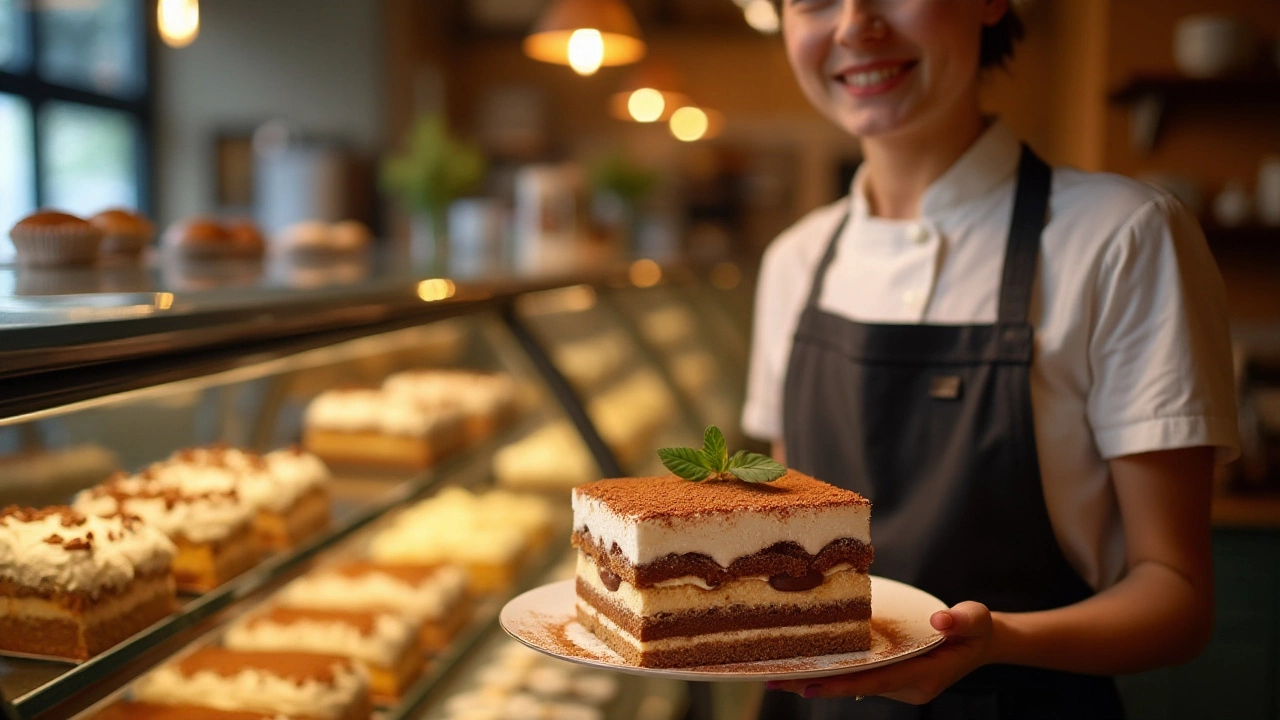
Tiramisu speaks softly of love in the language of Italian sweet treats. From the moment you taste the layered bliss of ladyfingers, espresso, and creamy mascarpone, you are taken on a delicious journey through Italy's rich culinary landscape. Though modern in appearance, this dessert holds a deep-rooted place in Italian tradition, evoking warmth and togetherness.
Whether you're a seasoned baker or a passionate foodie, understanding tiramisu involves appreciating its seamless blend of simple ingredients that come together in a sophisticated dance of flavors. Let's delve into this enchanting treat, exploring its origin, ingredients, variations, and even a peek into how you can make it at home.
- The Origin of Tiramisu
- Iconic Ingredients
- Variations Around the World
- The Perfect Recipe
- Cultural Significance
The Origin of Tiramisu
The origin story of tiramisu is as layered and intriguing as the dessert itself. Although this sweet delight is now cherished worldwide, its roots are deeply planted in Italy, the land known for its love of food and tradition. Emerging in the latter part of the 20th century, tiramisu's history is a blend of mystique and romance. Its name, which translates to "pick me up" or "cheer me up," hints at its beginning as a spirited pick-me-up, thanks to the fusion of coffee and cocoa.
The historical timeline of tiramisu is hotly debated, with several Italian regions claiming its birthplace. Many believe it started in the Veneto region, specifically in Treviso, where some say it first appeared in a restaurant named Le Beccherie. As the story goes, it was invented by pastry chef Roberto Linguanotto and his apprentice Francesca Valori, whose maiden name intriguingly was Tiramisu. However, variations of tales suggest that the concoction was originally crafted as an aphrodisiac — a testament to the potency of its coffee-soaked foundation.
Interestingly, some culinary historians argue that a dessert resembling tiramisu existed in the Italian region of Tuscany during the Renaissance. The Grand Duke Cosimo III is said to have been indulged with a similar layered dessert, hinting that the inspirations for tiramisu may date back centuries. Despite the uncertainty of its precise beginnings, what is universally agreed upon is that the dessert became popular in Italy in the 1980s and subsequently, the entire world fell in love with it.
The famous food critic, Stefano Bonilli, once noted, "The beauty of tiramisu lies not just in its taste, but in its rich history and the debates it sparks among those who adore it."
Today, tiramisu is celebrated not just for its taste but for its ability to capture the warmth and comfort of Italian culture. Whether served in a bustling trattoria in Rome or a chic New York bistro, the sweet taste of tiramisu carries with it a rich historical narrative, connecting those who enjoy it to its storied past. As home cooks and pastry chefs around the globe add their personal touches to its classic recipe, the tiramisu's evolution continues to mirror the diverse tapestry of its rich historical journey.
Iconic Ingredients
At the heart of every great tiramisu is the cherished blend of simple yet remarkable ingredients, each lending its voice to a harmonious symphony of taste and texture. Anchoring this dessert is the humble ladyfinger, or savoiardi, crisp and poised to absorb robust espresso. A step into tradition reveals the artisanal preparation of these delicate fingers, often homemade in the kitchens of Italy's grandmothers, adding a personalized touch that store-bought versions, while convenient, often lack. The key is their perfect absorption capability – they soak up the coffee, crafting a flavor bridge between creamy layers.
The coffee itself plays a pivotal role, with many purists insisting that only a dark, freshly brewed espresso suffices. This caffeine-rich infusion not only offers a bitter depth to counter the dessert's inherent sweetness but also whispers tales of Italian café culture, where espresso is more than drink; it's a ritual. Sweetening up this interplay is a sprinkling of sugar, judiciously used to balance the bitter notes without overpowering them. This sugar-espresso dance is what gives tiramisu its characteristic energy and allure.
Next is the rich mascarpone cheese, an ingredient whose creation is nothing less than culinary chemistry. This Italian cheese's creamy texture and mild flavor provide a lush, velvety backdrop that supports yet doesn't overshadow the other elements. It melds seamlessly with egg yolks and sugar, in a mix that many compare to creating edible silk. An equally important addition is the whipped egg whites or, in some modern adaptations, heavy cream, which lightens the mascarpone mixture, infusing airy elegance into each spoonful. The interplay between these elements is what transforms the dessert from everyday to extraordinary.
Cocoa powder completes the flavor profile, dusted liberally across the top layer to create a visual and gustatory contrast. Each bite brings a bitterness that cuts through the richness, providing a sense of balance akin to a well-composed melody, where each note is essential to the whole. It's not merely a garnish but an integral piece of tiramisu's identity. This finishing touch often carries with it personal interpretations, hinting at the dual nature of chocolate as both indulgent and necessary.
The New York Times once noted, "Tiramisu's simplicity is deceptive; its ingredients are singularly special and their chemistry, divine."
Crafting a perfect tiramisu requires an appreciation for these ingredients, where each plays its part not just in flavor but in texture and structure. The secret, though, lies in their quality and the love with which they are combined, a simple yet profound reminder of why this dessert remains a beloved global favorite.

Variations Around the World
The enchanting allure of tiramisu has traversed borders and ignited imaginations, leading to a myriad of adaptations that reflect local tastes and ingredients. One could stroll through the bustling streets of Paris and find a delicate rendition of tiramisu where the traditional espresso is swapped with rich French coffee, and the ladyfingers are dazzled with a whisper of vanilla. Interestingly, in parts of America, this classic dish is often infused with a touch of bourbon or brandy, adding an intoxicating depth to the creamy mascarpone layers that few can resist.
In Japan, where culinary innovation is a hallmark, matcha tiramisu has gained significant popularity. Here, the bitterness of matcha tea complements the sweetness of the mascarpone, offering a unique balance that intrigues the palate. Similarly, in the bright and festive food markets of Mexico, one might discover a tiramisu twist with a layer of cinnamon-spiced cookies replacing classic ladyfingers— echoes of a traditional María cookie—imparting a warm, autumnal flavor profile.
Across the Mediterranean, Greek baklava tiramisu emerges as a compelling fusion. The crispy, nutty baklava meets the creamy, coffee-infused tiramisu for a sensational marriage of textures and flavors, a testament to the creative reinvention this dessert inspires. In Australia, one might find renditions featuring their famed salted caramel, which adds an addictive sweet-salty balance to the dessert's famed layers, making each bite a true indulgence.
Distinctively, vegan and health-conscious versions of tiramisu have also risen to popularity, aligning with global dietary trends. These adaptations often employ almond or coconut-based creams and use gluten-free biscuits, allowing those with dietary restrictions to enjoy this delightful dessert. The proliferation of these variations showcases tiramisu's versatility and universal appeal, illustrating how it can be both playfully adapted and deeply grounded in cultural identity.
"Tiramisu's omnipresence and adaptations globally exemplify how culinary boundaries are increasingly blurred, leading to flavor innovations that both surprise and delight," says renowned chef Massimo Bottura.
Such creative endeavors highlight not just a love for this dish but also a testament to humanity's endless adaptability. Whether it’s spiced, boozy, or presented in a healthier form, tiramisu continually finds relevance and resonance. This adaptability is perhaps what catapults it into the realm of culinary legend, shared across diverse settings yet universally beloved.
The Perfect Recipe
Creating the perfect tiramisu at home is both an art and a science. This cherished dessert has a simplistic elegance that lies in the precise combination of its basic components: ladyfingers, espresso, mascarpone cheese, eggs, sugar, cocoa, and often a hint of liqueur. The magic happens when these ingredients merge harmoniously to form a dish that exudes both warmth and sophistication.
To start, gather fresh and high-quality ingredients. The ladyfingers, known as savoiardi, should be crisp and light, ready to absorb the bold espresso flavors. Coffee enthusiasts suggest using a strong, freshly brewed espresso for the most authentic taste. Mascarpone, a key ingredient, must be creamy and smooth, adding richness to balance the espresso's intensity. Many recipes call for eggs, with the yolks used to create a smooth zabaglione – an Italian custard that contributes a subtle depth of flavor, while the whipped egg whites add airy lightness to the final dessert.
Prepare the espresso and let it cool to room temperature. Meanwhile, in a mixing bowl, beat egg yolks and sugar until they form a pale, creamy mixture. Gradually incorporate the mascarpone into this mixture, stirring gently to achieve a smooth consistency. Separately, whip the egg whites to stiff peaks before gently folding them into the mascarpone blend, creating a light, fluffy texture.
"Tiramisu is more than just a dessert; it’s an experience that embodies the lively spirit and comforting warmth of Italian dining," says culinary expert Lidia Bastianich.
With your mascarpone mixture ready, it's time to assemble the dessert. Briefly dip each ladyfinger into the cooled espresso, ensuring they're well-soaked but not soggy – the ideal texture is crucial to the final product. Lay the first layer of soaked ladyfingers in the bottom of a serving dish. Spoon a generous amount of the mascarpone mixture over this layer, spreading it evenly. Repeat the process with another layer of ladyfingers and mascarpone, usually creating two or three tiers in height.
Once assembled, the finishing touch is a dusting of unsweetened cocoa powder over the top layer of mascarpone. This delicate garnish adds a hint of bitterness, cutting through the dessert's creamy richness. For added depth, some recipes incorporate a sprinkle of grated chocolate or a dash of rum or Marsala wine into the espresso. The tiramisu should be refrigerated for at least four hours, or preferably overnight, allowing the flavors to meld together for a truly delightful experience.
With its simple yet indulging taste, tiramisu remains a formidable choice for dessert lovers around the world. It's a testament to the notion that the most elegant creations often rely on balancing just a few pivotal ingredients. The interplay of texture and taste in tiramisu makes it a versatile masterpiece, evolving gently with every spoonful.

Cultural Significance
The allure of tiramisu goes far beyond its tantalizing taste. This dessert has woven itself into the fabric of Italian culture, representing not just an indulgent treat, but a symbol of hospitality and celebration. Originating in the Veneto region during the 1960s, tiramisu quickly rose to fame across Italy and eventually, the entire world. Its name, meaning "pick me up" in Italian, aptly reflects its uplifting effect on spirits and taste buds alike.
In Italy, dining is not merely about nourishment; it's a cherished ritual. It is during these meals where desserts like tiramisu play a pivotal role, offering a sweet conclusion to a communal feast. Often shared among family and friends, a well-made tiramisu embodies the warmth of home, echoing the joy of gatherings that span generations. It serves as a delicious reminder of life's simple pleasures.
According to Italian chef Gino D'Acampo, "Tiramisu is not just a dessert, it's part of our identity, a reflection of Italian dolce vita."
Tiramisu has transcended its Italian roots, becoming a global ambassador of Italian culinary excellence. Many restaurants worldwide feature it as a popular dessert option, celebrating its rich heritage and simple elegance. This worldwide appreciation has spurred variations that cater to local tastes, from matcha tiramisu in Japan to a limoncello-inspired version in southern Italy. While these adaptations pay homage to the original, they spotlight the dessert's versatility and universal appeal.
The influence of tiramisu in popular culture is notable, featuring prominently in movies, literature, and music as a token of elegance and indulgence. Its presence often signals sophistication and warmth, underscoring the dessert's lasting impact on culinary arts. Many chefs consider perfecting a classic tiramisu a rite of passage, highlighting how its preparation balances technical skill with a dash of creativity.
Events centered around the celebration of tiramisu illustrate its deep-seated cultural significance. Annual festivals in Italy invite both amateur and professional chefs to showcase their personal takes on the beloved dessert, fostering a sense of community and shared passion. These gatherings remind us of how food can unite people from all walks of life, breaking boundaries and building connections through shared tasting experiences.
In our digitally connected world, tiramisu continues to enchant food enthusiasts on social media platforms. Photos and videos capturing the making and enjoyment of tiramisu generate immense engagement, reflecting the timeless fascination it inspires. Its popularity online serves to further spread its culinary legacy, ensuring that it remains a cherished aspect of global food culture.